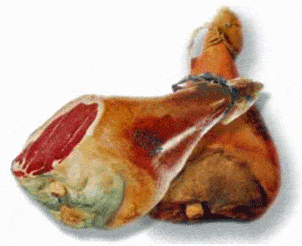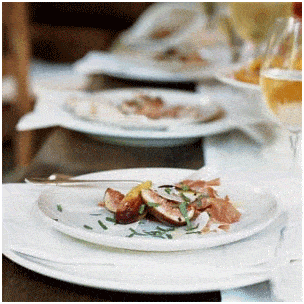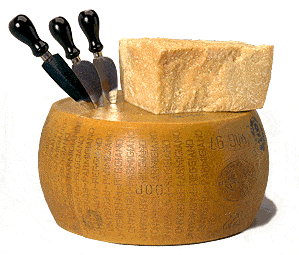
By Judy J. Pinegar
Parma ham is known the world over as Prosciutto de Parma and is made from a pig’s hind leg or thigh. The entire zone for producing this delicately-textured raw ham is within the Province of Parma, in the Emilia-Romagna region of Northern Italy. Its boundaries begin five kilometers south of the via Emilia, run to the shores of the Ena River in the east, and to the Stitrone River in the west. Parma Ham is also guaranteed by a consortium, Consorzio del Prosciutto di Parma, which protects and controls quality and production in the 164 producing companies, 5,000 pig farms with a total economic impact of 1.7 billion euros.
The legs are first cleaned, salted and left for up to two months. Two types of salt are used in the process – “wet” salt covers the exposed part of the meat to keep it moist and “dry” salt is used for the rest of the leg. The leg also needs to be at the right temperature: too cold and it will not absorb enough salt; too warm and it might start to spoil. The curing rooms are on upper floors of the curing house where the temperature and humidity are dictated by nature. The only control is the breeze passing through the many windows and occasionally a dehumidifier. Some medium size firms employ a person whose only job is to open and close the windows
Then the excess salt is removed, and a lighter coating of salt is added to continue the salting process. No other additives or preservatives are used, and it’s absolutely forbidden to freeze a leg that will become Prosciutto di Parma. During the salting process, the prosciutto are given “massages” to remove all of the blood still left in the meat.
After the salting process, the prosciutto are again washed , salted more lightly and hung to dry – usually in climate-controlled rooms so that the air temperature is the same, and most importantly, dry. If there is too much moisture in the air, the meat will spoil instead of curing. The air is also changed frequently. The air is important to the final quality of the ham, the best results are obtained in the cold climate of northern Italy. The amount of time this takes varies, depending on the local climate and size of the ham.
After it’s dried sufficiently, the prosciutto leg is spread with sugna . Sugna is rendered pork fat, which is spread over the exposed part of the prosciutto by hand. Usually the fat is mixed with spices like salt and pepper. The sugna helps protect the exposed part of the prosciutto and keep it from drying out excessively with respect to the interior part of the prosciutto, and therefore ensures you a slice of prosciutto that is tender and moist the entire way through.
At the seventh month, after the sunga is applied, they are moved to cellars for 10-12 months (based on weight) for the maturing period. After the maturing period, a horse bone “needle” is inserted in five points of the joint and the bone is then smelled by master tester for uniformity of aroma and maturation. The needle is inserted into the area covered by the sugna and then the tester will cover up the hole made with the needle with his hand. Only after all passing all these previous steps will finally be fire-branded “Prosciutto di Parma” with its distinct “corona a 5 punte” – a 5 pointed crown brand and the manufacturer’s identification. At this point in time the hams will have lost around 30% of their total weight and the entire process takes up to 18 months.
Sliced prosciutto crudo in Italian cuisine is often served as an antipasto, wrapped around grissini (breadsticks) or, especially in summer, cantaloupe or honeydew. It is eaten as accompaniment to cooked spring vegetables, such as asparagus or peas. It may be included a Tuscan dish of tagliatelle and vegetables, in a filled bread, or as a pizza topping. Saltimbocca is a famous Italian veal dish, where escallops of veal are topped with a sage leaf before being wrapped in prosciutto and then pan-fried. Prosciutto is often served in Panini and sandwiches, sometimes in a variation on the Caprese salad, with basil, tomato and fresh mozzarella. A basic sandwich served in many Italian cafes and bars consists of prosciutto in a croissant.
So picture yourself on a street-side cafe in the Emilia-Romagna region. Your first course is pink, transparent slices of Prosciutto di Parma, fanned out around shaved Parmigiano-Reggiano, soft, plump, green and purple quartered figs and thinly cut mint leaves on a simple white plate. Alongside it stands a glass of golden-tinged Malvasia wine. Sometimes the traditional ways really are the best!

Figs and Prosciutto with Mint and Shaved Parmigiano-Reggiano
Ripe figs are the secret to this simple yet refined salad. It’s best made just before serving.
Ingredients
- 8 fresh figs, quartered
- 2 teaspoons extra virgin olive oil
- 1/4 teaspoon cracked black pepper
- 1 ounce Parmigiano-Reggiano cheese, thinly shaved
- 12 mint leaves, thinly sliced
- 4 ounces thinly sliced prosciutto
Preparation
Place figs in a bowl; drizzle with oil. Sprinkle figs with pepper; toss gently. Place fig mixture in the center of a platter; top with cheese and mint. Top with prosciutto.
Yield: 8 servings (serving size: 4 fig quarters, about 1/2 ounce prosciutto, and 1/8 ounce cheese)
Recipe Courtesy of Cooking Light
Source: Judy J. Pinegar
Writer and World Traveler
If you have writing needs you may contact Judy through me:
John J. O’Dell
Real Estate Broker
O’Dell Realty
(530) 263-1091
Email John at jodell@nevadacounty.com
DRE# 00669941
